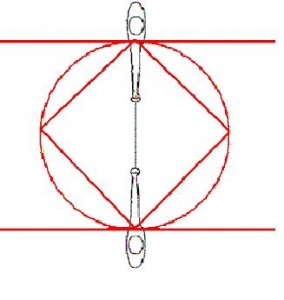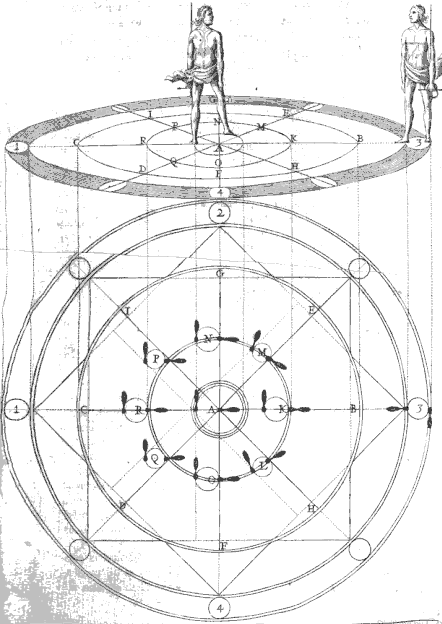One day in Dijon…
This is Emma Rios practicing Destreza at 2013 in competitive play:
First, posting a video of your fencing is an act of bravery for a fencer or an instructor. If we are to believe what we read on the forums the internet is filled with super-ninjas who can readily find fault with anyone else’s practice even if they have never gotten out of their own chair to fence themselves. I don’t put much faith in the armchair-ninja crowd but I do appreciate it when someone practicing in a tradition I study shares their work and for that I thank her and the school she trains with.
I wanted to specifically talk about the Destreza that is working here and how I perceive the tradition in her practice. Because I have never met Emma, this will be speculative but I hope it will be informed by the primary sources and that my analysis will help someone who is unfamiliar with Destreza understand why her strategy is working and where it comes from.
The First Rule is to Defend
In Italian fencing there exists an imaginary line between two adversaries called the line of direction. It is the shortest path to the target.
In the True Destreza (LVD) there is the Diameter. The Diameter of the common circle is defined by the Medio de Proporcion which we might call the defensive medio. It is the balance point from which we transition to ‘out of distance’ into our first opportunity for offense but with an eye fixed on our defensive place. Ettenhard also tells us that it is the distance at which we can still safely react in time to form a defense. You can think of a medio as a beautiful balance point chosen by reason, knowledge, and experience.

The Medio de Proporcion defines the Diameter which also defines the Common Circle shared by the two adversaries.
You could also visualize the defensive medio as a bubble around you which defines the area you must keep clear to effectively defend yourself. Rada calls this sphere required for effective defense the Maximum Orb and the Medio de Proporcion defines the Radius of a personal safety bubble.

Rada’s Maximum Orb shows a defensive space defined by the Medio de Proporcion. The Maximum Orb is your personal space.
Consider the video and watch how Emma places her Italian adversary in the center of the fighting space (just as we see in the image above) and then she continually probes and pressures the edges of the adversary’s safe space to threaten. (I want to be very clear that Emma is walking the circumference of the Maximum Orb and not the Common Circle. Walking the Common Circle is akin to suicide without control of the blade or the time because you are closing distance.)
The Italian fencer seems absolutely baffled and doesn’t have an answer for the continuously changing place of the fight. Emma’s control of the place and her ability to gauge distance against a refused blade is key to her success in shutting down the adversary’s offense. When the attacks arrive, she has the training to receive them and respond with a defense-offense action. (Atajo and cut typically.)
- Key Point – Defense by control of the Medio de Proporcion (MdP).
- Key Point – Force the adversary into your strategy while denying them their own.
- Key Point – Train to know your distance and how to gauge your adversary’s distance.
Spirals Control Threat-Space
Pacheco tells us that fencers that want to attack the hand will often keep their blade held well back which is what we observe here in Emma’s opponent. His answer is to circle the adversary and create spirals as if we were executing the General Treta of the Weak Under the Strong (a clockwise spiral) which forms a sort of invitation and time-thrust all executed as a circular blade action. Circular parries, envelopments, and other blade spirals control regions of space and working from the defensive medio (or just outside it) means that the risk for creating the spirals is reduced.
This appears (to me) to be Emma’s other well-trained strategy for frustrating the adversary. An Italian wants to find your blade with a gain and then lunge straight. Emma is refusing to stay on the line, keeps her distance well, and frustrates the attempts to gain (or even find position) by following Pacheco’s advice and creating spirals while circling with her footwork but she never gets so close that she loses the ability to defend.
- Key Point – The further away from the adversary you are, the less risky it is to move your weapon.
- Key Point – Spirals control or regain control of space.
- Key Point – A continuously moving blade is harder to gain.
My personal favorite is the atajo on the outside line and medio tajo at about 35 seconds. Do I completely agree with every movimiento in the fight? No, but I don’t need to agree universally to appreciate the training. The tradition has space for lots of difference, diverse schools, and cultures. What is important to me is that someone shared their work in a tradition that I feel strongly about and I think the work was good. If more people were as courageous as Emma and posting their own videos of LVD in action we would create a world community of Destreza practitioners and that would be good for the art and the science.

